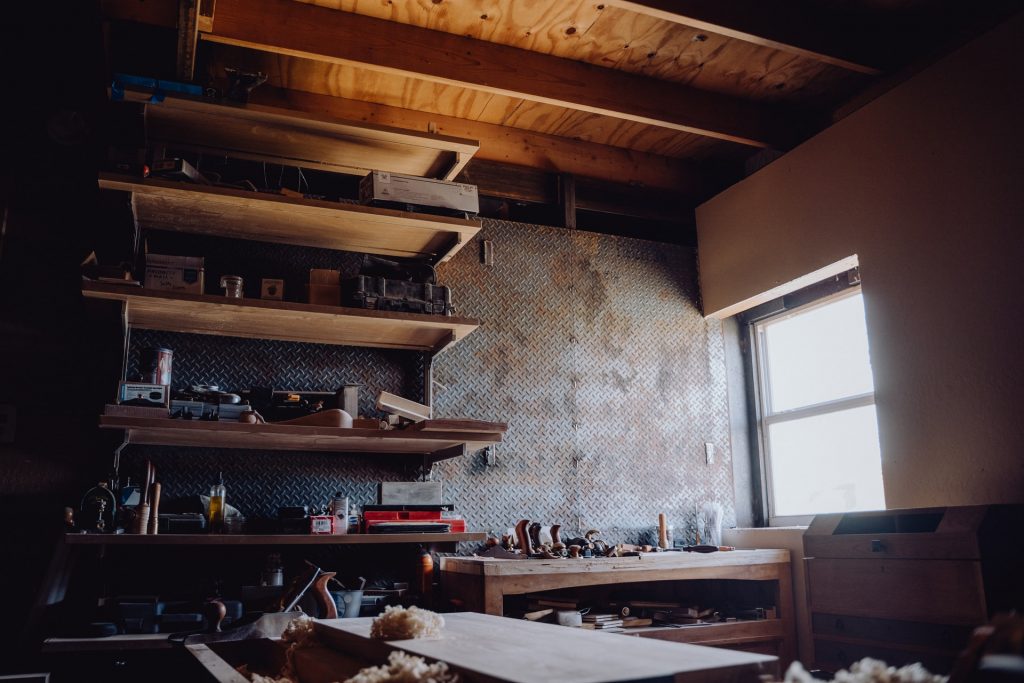The laser guide on electric miter saws is a great feature since it helps you with complex cuts that would otherwise be very difficult.
That being said, if the laser is not calibrated properly, it can cause a lot of problems and can result in extremely inaccurate cuts.
Quick Summary
In this post, we will discuss:
- How the laser on a miter saw works
- How you can use it effectively
- How to recalibrate it if it’s not adjusted properly
So without further ado, let’s get into it.
How the Laser Works?
Most people have the idea that the laser being emitted from the saw actually lands right on the cut line.
This is actually not the case.
If the laser is calibrated properly, then it’s supposed to lie just to the left of the kerf of the blade. It just barely touches the cut itself.
This might seem counterintuitive at first but having the laser slightly to the left side of the kerf actually makes the cutting process much easier. That’s because it makes it very easy to set up the cut.
Simply draw your cut line on the workpiece and then, line it up with the right edge of the laser. This will ensure your mark is on the left edge of the blade itself.
Please note that if you intend to make your cuts this way, this will mean that the waste side of the board has to be to the right of your mark.
Some Safety Precautions

Before we get into the process of actually adjusting the laser, we want to go over some safety precautions you should take.
This is because, in order to adjust the laser, you will need to do some cutting on some scrap materials. Hence, you should take the same precautions you would if you were doing a real job.
Some precautions to take include:
- Wear safety gloves or some sort of protection for your hands. You don’t want to cut your hands while you’re operating a high-powered miter saw.
- Wear safety goggles or some other sort of eye protection. You only have two eyes and if a fast-flying piece of timber goes into one of them, you could be in a lot of trouble.
- Do not wear loose clothing. Make sure to wear clothes that are tight so they don’t get caught in any moving parts.
- If you have long hair, tie them up properly so they don’t get caught in any moving parts.
- Make sure that you work in a well-ventilated area. If your workspace is not well-ventilated, make sure to at least wear some sort of breathing mask.
Once you’ve taken all of the necessary precautions, you can go ahead and start to adjust the laser to suit your needs.
How to Adjust the Laser on a Chicago Electric Miter Saw (Step-by-Step Guide)
To correctly adjust the laser guide on a Chicago electric miter saw, you will need a few scrap materials. You will use these scrap pieces of wood to make your cuts and check whether or not the laser is properly aligned.
To correctly adjust the laser on a Chicago electric miter saw, follow these steps:
Step 1: Take a nice, flat piece of scrap board. Preferably, it should have a straight edge that can be put up against the fence.
Step 2: Use the miter saw’s hold-down clamp to firmly and securely hold the scrap board in place.
Make sure that you leave a lot of room for the scrap board on either side of the blade.
If your Chicago electric miter saw didn’t come with such clamps, you can easily buy them online or from your local hardware store.
Step 3: Make sure that your miter saw and the board itself are firmly held in place so that they don’t accidentally move.
Step 4: Turn on your Chicago electric miter saw and gently push it down into the scrap board to make a small cut.
Don’t cut all the way through the board. Just make a cut that’s big enough to be apparent.
Step 5: Once you have made the cut, you have a reference for where the blade would land on the board if you didn’t make any adjustments.
Without moving the board or the electric miter saw itself, turn on the laser guide and see where it lands on the board.
Step 6: If the laser guide is not correctly calibrated, then it may be far off from where you made the cut line in step 4.
Hence, this is where you can easily make the adjustment to it. Again, without moving the scrap board or the miter saw itself, start to adjust the position of the laser.
You should bring it to a position where the laser just touches the left side of the cut you made in step 4.
Step 7: That’s pretty much it. Your laser is now fully and properly calibrated.
If in the future, you start to feel that the laser line is messing up again, you can use this same method again to recalibrate it. Problems in calibration can definitely occur over time and it’s something you should come to expect as a woodworker.
Indeed, many veteran woodworkers routinely check the calibration on their lasers to ensure that everything is on point.
To correctly adjust the laser guide on a Chicago electric miter saw, you will need a few scrap materials. You will use these scrap pieces of wood to make your cuts and check whether or not the laser is properly aligned.
To correctly adjust the laser on a Chicago electric miter saw, follow these steps:
Step 1: Take a nice, flat piece of scrap board. Preferably, it should have a straight edge that can be put up against the fence.
Step 2: Use the miter saw’s hold-down clamp to firmly and securely hold the scrap board in place.
Make sure that you leave a lot of room for the scrap board on either side of the blade.
If your Chicago electric miter saw didn’t come with such clamps, you can easily buy them online or from your local hardware store.
Step 3: Make sure that your miter saw and the board itself are firmly held in place so that they don’t accidentally move.
Step 4: Turn on your Chicago electric miter saw and gently push it down into the scrap board to make a small cut.
Don’t cut all the way through the board. Just make a cut that’s big enough to be apparent.
Step 5: Once you have made the cut, you have a reference for where the blade would land on the board if you didn’t make any adjustments.
Without moving the board or the electric miter saw itself, turn on the laser guide and see where it lands on the board.
Step 6: If the laser guide is not correctly calibrated, then it may be far off from where you made the cut line in step 4.
Hence, this is where you can easily make the adjustment to it. Again, without moving the scrap board or the miter saw itself, start to adjust the position of the laser.
You should bring it to a position where the laser just touches the left side of the cut you made in step 4.
Step 7: That’s pretty much it. Your laser is now fully and properly calibrated.
If in the future, you start to feel that the laser line is messing up again, you can use this same method again to recalibrate it. Problems in calibration can definitely occur over time and it’s something you should come to expect as a woodworker.
Indeed, many veteran woodworkers routinely check the calibration on their lasers to ensure that everything is on point.
Gather all the resources and supplies you might need.
My Laser Travels Left and Right When I Lower My Blade. What Do I Do?
This is a common problem that can sometimes occur with fault lasers and/or miter saws.
It’s not a problem we’ve come across with Chicago miter saws but it’s definitely a known issue with lower-end miter saws.
There’s no need to worry if your laser level is traveling left and right when you lower the miter saw onto the workpiece.
All you have to do is calibrate it so that it aligns properly when your miter saw is held upright. Once you’ve made that calibration, you’re golden.
Simply take note of where you want the cut to be made when the blade is held upright. Once that’s done, simply lower the blade directly into the workpiece while ignoring the laser that’s jumping around.
The cut will be made accurately.
Wrapping Things Up…
That’s how you adjust a laser on a Chicago Electric Miter Saw.
To be fair, this same method can be used to adjust the laser on pretty much any miter saw that you have.
If you’re having problems with adjusting your laser, please reach out to us in the comments section below.
If you want to know more about Chicago Miter Saw, check out our website.

